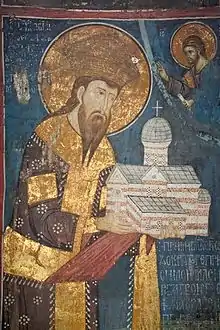Zvečan Fortress
The Fortress of Zvečan (Serbian: Тврђава Звечан / Tvrđava Zvečan, Звечански град / Zvešanski grad; Albanian: Kalaja e Zveçanit), also known as Zvečan/Zveçan medieval fortress[1] and Fortress of Mitrovica (Albanian: Kalaja e Mitrovicës), located in the north-west of the city of North Kosovska Mitrovica, in North Kosovo[a], is an enormous castle and one of the oldest fortresses in South Eastern Europe. It was built on the top of the extinct volcano vent, overlooking the Ibar river.
| Zveçan Zvečan Звечан | |
|---|---|
| Kosovska Mitrovica, North Kosovo | |
 Overview of the Zvečan fortress | |
| Type | Fortification |
| Site history | |
| Built | 11th century |
| Built by | Vukan Vukanović |
| Materials | Stone |
Zvečan Fortress was declared Monument of Culture of Exceptional Importance in 1990, and it is protected by the Republic of Serbia, although lying within Kosovo.
History
It represents one of the oldest Balkan medieval fortresses, although its exact date of construction is unknown. The underlying construction dates from the period of classical antiquity, and it is not unlikely that the location was fortified in prehistoric times. As a border fort of Grand Principality of Serbia, the fortress gained importance in 1093, when the Serbian ruler Vukan, launched his conquest of the Kosovo region (then part of the Byzantine Empire) from there.


Right: Stefan Dečanski, King of Serbia, died in Zvečan Fortress
Part of the fortress was designated as one of the courts of the Serbian House of Nemanjić, and it was the place where Stefan Uroš III died in 1331. In 1389, it was captured by the Ottoman Turks after the Battle of Kosovo, and it remained an active military site well into the 18th century, after which it was abandoned.
According to some data from the Roman times, the medieval town Zvečan, just as all the towns of the time, was built on a barely accessible hill in the base of which was the architecture of the early Byzantine period. The archeological data up to the 9th century are rather scanty as well as the written documents about it.
Only by the beginning of the 10th century was the fortress on the hill mentioned for the first time, its reconstruction being ascribed to the Bulgarian Czar Simeon. By the end of the 11th century it was referred to as the Serbian fortress, held by some rulers of the Grand Principality of Serbia, who used it in their struggle against Byzantine.
The town gradually grew gaining its importance at the time of spreading of the Serbian state southwards in the conflicts with Byzantine. As a strategic fortress, Zvečan was mentioned in 1092 and 1093 since in its area the roads from the north and south intersected playing a significant role in military and trading sense. During the reign of Grand Prince Vukan I of Serbia (by the end of the 11th century), the area of Kosovska Mitrovica was the battlefield in Vukan’s campaign against Byzantine and his brother Tihomir winning at last near the village of Pantina.

Thick and high walls of Zvečan fortress at the Nemanjić’s time, served not only for protection against the enemy’s assaults but also as a shelter for the merchants from Dubrovnik as well as a dungeon for the overthrown rulers of the Nemanjić’s lineage. Thus Konstantin Nemanić, Stefan Dečanski’s stepbrother, was buried here in 1322.
King Stefan Dečanski himself was imprisoned and ended his life there (1311) after having been caught in Petrič according to his son Dušan’s order. For some time, the ruler of Zvečan was Grand Prince Lazar’s son-in-law, the chieftain Musa, at the time of Czar Uroš. By the end of 14th century Zvečan was under the rule of Vuk Branković and after his fall from power, the Turks appeared in Zvečan.
Zvečan finally fell into Turkish power in 1455, when the Turkish population colonized these areas. Among whom Feriz Ćefalija was mentioned to have an authorization from the Sultan and Pasha from Skoplje to make trading connections with Dubrovnik. By its subjection to Turkish rule, Zvečan lost its importance as a military fort and the authors of the travel books from the 16th century, Benedicte Kuripešić and Evlija Čelebija referred to its as a deserted town on the hill to the north of Kosovska Mitrovica.
Under Turkish-Ottoman rule, Zvečan was neglected and was in the possession of the Bosnian Vilayet. Eventually, Kosovska Mitrovica became a kadiluk (district) of the Bosnian vilazet and Zvečan, along with Kosovska Mitrovica, remained in that administrative until 1877, and it, as it too was a part of Kosovska Mitrovica, belonged to the Priština region (Sandžak) until the region's liberation in the First Balkan War, in 1912.
From 1912-45, little was done on the research and restoration of Zvečan; it was only after 1945 when many archeological excavations were carried out in the town which was put under the protection of the state. There is a need for complete reconstruction of the fortress in order to prevent it from further ruining.
See also
- Monument of Culture of Exceptional Importance
- List of castles in Kosovo
- List of fortifications in Serbia
Notes
| a. | ^ Kosovo is the subject of a territorial dispute between the Republic of Kosovo and the Republic of Serbia. The Republic of Kosovo unilaterally declared independence on 17 February 2008. Serbia continues to claim it as part of its own sovereign territory. The two governments began to normalise relations in 2013, as part of the 2013 Brussels Agreement. Kosovo is currently recognized as an independent state by 98 out of the 193 United Nations member states. In total, 113 UN member states recognized Kosovo at some point, of which 15 later withdrew their recognition. |

